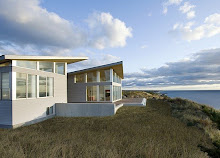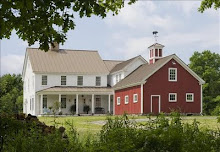
The Ostrich reproduction ceiling fan from the Woolen Mill Fan Company
I am a huge fan of ceiling fans. My reasons?
- EFFICIENCY - Ceiling fans are an important component of an overall passive cooling strategy, which includes orientating the building with respect to sun and breezes, cross-ventilation and super-insulation.
- SKIP THE AIR CONDITIONING - Fans enable you to greatly reduce or eliminate air conditioning (which is a huge energy drain, and relies on a blowing ducted system prone to dust and mold growth)
- NOISE REDUCTION - Ceiling fans are quiet, especially if you invest in a quality fixture
- HEAT CONSERVATION - They help lower heating bills in the winter by running clockwise to push warm air near the ceiling back down into the space, and offer an important assist to passive heating strategies
- STYLE - The right fan can make a beautiful design statement
 Air conditioning represents more than half of Heating, Ventilation and Cooling (HVAC) use in the US... that's a whopping 15% of total US electricity consumption, according to the US Energy Information Administration.
Air conditioning represents more than half of Heating, Ventilation and Cooling (HVAC) use in the US... that's a whopping 15% of total US electricity consumption, according to the US Energy Information Administration.Now, I admit that ceiling fans are not typically high on an interior designer's priority list. We have become accustomed to cheap "builder special" fans that are unattractive, collect dust and wobble threateningly on medium speed. Usually they are the first things to go when remodeling a space.
Here are a few "keepers" from classic to retro to modern, for your consideration.
 The Acero, made by Minka Aire, but available in nice bronze finish with tobacco blades combination from Restoration Hardware.
The Acero, made by Minka Aire, but available in nice bronze finish with tobacco blades combination from Restoration Hardware.
Inspired by falling seed pods, the Sycamore Ceiling Fan promises ground-breaking energy efficiency.

The Brewmaster reproduction belt-driven fan, from Fanimation.
 The industrial-style Loft ceiling fan from Emerson is powerful, but "detuned" for safe, quiet use in residential spaces. THE CONCORD GREEN HEALTHY HOME will feature this beauty in the gable kitchen ceiling, where southern exposure, skylights and cooking will make it one of the hotter spaces in the house.
The industrial-style Loft ceiling fan from Emerson is powerful, but "detuned" for safe, quiet use in residential spaces. THE CONCORD GREEN HEALTHY HOME will feature this beauty in the gable kitchen ceiling, where southern exposure, skylights and cooking will make it one of the hotter spaces in the house.Turn Off When not in the Room
Ceiling fans cool people, not rooms. If the room is unoccupied, turn off the ceiling fan to save energy.Using the Ceiling Fan Year Round
In the summer, use the ceiling fan in the counterclockwise direction. While standing directly under the ceiling fan you should feel a cool breeze. The airflow produced creates a wind-chill effect, making you "feel" cooler. In the winter, reverse the motor and operate the ceiling fan at low speed in the clockwise direction. This produces a gentle updraft, which forces warm air near the ceiling down into the occupied space. Remember to adjust your thermostat when using your ceiling fan — additional energy and dollar savings could be realized with this simple step!SHOPPING TIP
I highly recommend shopping at HansenWholesale.com for ceiling fans. They have a terrific online rating system for most brands, and provide personal shopping assistance for all of your needs.



































These are some pretty cool ceiling fans. I never realized how much money you could save by using a ceiling fan
ReplyDeletethe perfect ceiling fans
ReplyDeleteI really love those axial fans. Manufacturers of that kind of fans really knows how to help their buyers into saving electricity and giving them the comfort that can't be found anywhere else.
ReplyDeleteLittle do we know that fans are everywhere, even in our precious computers, and even in our blow dryers too (specifically, centrifugal fan). Manufacturers of these fans are operational with machineries and impressive QA equipment, which provide us with quality products.
I have recently purchased two Hunter Ceiling Fans, and BOTH of them SMELL like a hot chemical soup when left on for more than a few minutes. These fans are nauseating with off-gassing VOCs that have made me physically sick. I have contacted the company, and have been waiting for a reply for over two weeks. In the meantime, I Googled 'Hunter Ceiling Fan + Chemical Smell or Odor' and have found that these types of consumer complaints have a history going back all the way to 2006. Hunter fans emit a noxious odor - BUYER BEWARE.
ReplyDelete